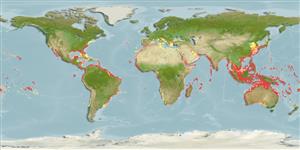分類 / Names
俗名 | 同種異名 | Catalog of Fishes(屬, 種) | ITIS | CoL | WoRMS | Cloffa
Elasmobranchii
板鰓亞綱 (鯊魚與魟魚) (sharks and rays) >
Carcharhiniformes (Ground sharks)
真鯊目 (Ground sharks) >
Carcharhinidae (Requiem sharks)
白眼鮫科 (Requiem sharks)
Etymology: Carcharhinus: karcharos (Gr.), sharp or jagged; rhinus, an ancient name for sharks, from rhine (Gr.), rasp, both words alluding to a shark's jagged, rasp-like skin. (See ETYFish); limbatus: Latin for edged or bordered, referring to black-edged fins [authorship often attributed to Müller & Henle, who published Valenciennes’ description]. (See ETYFish).
Environment: milieu / climate zone / depth range / distribution range
生態學
海洋; 半鹹淡水 礁區魚類; 非產卵性溯降河的 (Ref. 51243); 深度上下限 0 - 140 m (Ref. 106604), usually 0 - 30 m (Ref. 55184). 亞熱帶的; 45°N - 38°S, 180°W - 180°E (Ref. 55184)
Cosmopolitan. Western Atlantic: Nova Scotia, Canada to Brazil (Ref. 26340). Eastern Atlantic: Senegal to Democratic Republic of the Congo, Madeira, the Canary Islands, and Mediterranean (Ref. 244). Indo-Pacific: Persian Gulf (Ref. 68964), Red Sea, Madagascar and South Africa to China, Australia, Tahiti, Marquesas, and Hawaii. Eastern Pacific: Baja California, Mexico to Peru, including the Galapagos Islands.
四海為家的人。 西大西洋: 加拿大的新斯科舍省到巴西.(參考文獻 26340) 東大西洋: 塞內加爾到剛果,馬得拉群島,加納利群島與地中海。 印度-太平洋: 紅海,馬達加斯加與南非至中國,澳洲,大溪地島,馬可薩斯島與夏威夷。 東太平洋: 墨西哥的下加利福尼亞到祕魯, 包括加拉巴哥群島。
Length at first maturity / 大小 / 重量 / 年齡
Maturity: Lm 165.4, range 120 - 194 cm
Max length : 286 cm TL 雄魚/尚未辨別雌雄; (Ref. 106604); common length : 150 cm TL 雄魚/尚未辨別雌雄; (Ref. 9253); 最大體重: 122.8 kg (Ref. 4699); 最大年齡: 12 年 (Ref. 244)
背棘 (總數): 0; 背的軟條 (總數): 0; 臀棘 0; 臀鰭軟條: 0. A stout shark with a long, narrow, pointed snout, long gill slits and erect, narrow-cusped upper teeth; first dorsal fin high; no interdorsal ridge (Ref. 5578). Dark grey, ashy blue or dusky bronze on back, belly white or yellowish white; a dark band extending rearward along each side to about over origin of pelvic fin; tips of pelvic fins with a persistent black spot; tips of dorsal fins, pectoral fins, anal, and lower lobe of caudal fin usually black or dusky in young individuals, fading with growth (Ref. 9997).
一矮胖的鯊魚有一個長的﹐狹窄的﹐和尖的吻又長的鰓縫與直立的, 細尖的上顎齒; 第一背鰭很高; 沒有間背脊.(參考文獻 5578) 深灰色的﹐灰藍色或暗青銅色背面, 腹部白色或黃白色; 一個延伸的深色條紋向後沿著兩邊到大約腹鰭的起源上面; 腹鰭頂端具有一個持續的黑色斑點; 背鰭頂端,胸鰭, 肛門的, 與尾鰭的低葉通常黑色或暗色的在被隨著成長消失的幼魚中.(參考文獻 9997)
An inshore and offshore shark found on or adjacent to continental and insular shelves (Ref. 244). Often off river mouths and estuaries, muddy bays, mangrove swamps, lagoons, and coral reef drop-offs (Ref. 244). Bottom associated or pelagic (Ref. 58302). Young common along beaches (Ref. 9710). Active hunter in midwater (Ref. 5485). Feeds mainly on pelagic and benthic fishes, also small sharks and rays, cephalopods and crustaceans (Ref. 5578; 37816). Viviparous (Ref. 50449). Produces litters of one to 10 young (Ref. 26938, 1602). Incriminated in very few attacks but dangerous when provoked (Ref. 244). Often taken by shore anglers (Ref. 5485). Used fresh for human consumption, hides for leather, liver for oil (Ref. 244). Parthenogenesis has been observed in a captive female (Ref. 80664).
一種近岸的與外海鯊魚發現或之上鄰近大陸棚與島嶼棚.(參考文獻 244) 時常河口外與河口,泥濘的海灣,紅樹林沼澤,潟湖與珊瑚礁峭壁.(參考文獻 244) 底部聯合或大洋性的.(參考文獻 58302) 幼魚普遍沿著海灘.(參考文獻 9710) 在中層水域中的活躍獵人.(參考文獻 5485) 主要吃大洋性與底棲的魚,也捕食小的鯊魚與鰭條,頭足類動物與甲殼動物 (參考文獻 5578; 37816)。 胎生的.(參考文獻 50449) 對 10個幼魚每胎生產一。 (參考文獻 26938,1602) 少有攻擊案例但是危險的當被激怒時.(參考文獻 244) 時常採自.岸釣者。 (參考文獻 5485) 使用.新鮮的供人類消費,皮用做皮革,肝臟用於製造魚肝油。 (參考文獻 244)
Life cycle and mating behavior
成熟度 | 繁殖 | 產卵場 | 卵 | 孕卵數 | 仔魚
Distinct pairing with embrace (Ref. 205). Viviparous, with a yolk-sac placenta, 1 to 10 young per litter. Gestation period is 10 to 12 months. Nursery and pupping grounds are located inshore where pregnant females go to drop their young. Females are thought to spawn only every two years. Size at birth 38-72 cm (Ref. 244); 55-66 cm TL (Ref.58048).四海為家的人。 西大西洋: 加拿大的新斯科舍省到巴西.(參考文獻 26340) 東大西洋: 塞內加爾到剛果,馬得拉群島,加納利群島與地中海。 印度-太平洋: 紅海,馬達加斯加與南非至中國,澳洲,大溪地島,馬可薩斯島與夏威夷。 東太平洋: 墨西哥的下加利福尼亞到祕魯, 包括加拉巴哥群島。
Compagno, L.J.V., 1984. FAO Species Catalogue. Vol. 4. Sharks of the world. An annotated and illustrated catalogue of shark species known to date. Part 2 - Carcharhiniformes. FAO Fish. Synop. 125(4/2):251-655. Rome: FAO. (Ref. 244)
人類使用
漁業: 商業性; 游釣魚種: 是的
更多資訊
合作者照片Stamps, Coins Misc.聲音神經毒速度泳型鰓區Otoliths腦重體重比眼睛色素
工具
特別的報告
下載 XML
網路資源
Estimates based on models
Preferred temperature (Ref.
123201): 19.9 - 29, mean 27.4 °C (based on 3336 cells).
Phylogenetic diversity index (Ref.
82804): PD
50 = 0.5000 [Uniqueness, from 0.5 = low to 2.0 = high].
Bayesian length-weight: a=0.00468 (0.00396 - 0.00553), b=3.08 (3.04 - 3.12), in cm total length, based on LWR estimates for this species (Ref.
93245).
營養階層 (Ref.
69278): 4.4 ±0.4 se; based on diet studies.
回復力 (Ref.
120179): 低的, 最小族群倍增時間4.5 - 14 年 (rm=0.054; K=0.27; tm=3-8; tmax=18; Fec=1-10).
Prior r = 0.30, 95% CL = 0.19 - 0.48, Based on 1 stock assessment.
Fishing Vulnerability (Ref.
59153): High vulnerability (55 of 100).
Climate Vulnerability (Ref.
125649): Very high vulnerability (79 of 100).
Nutrients (Ref.
124155): Calcium = 4.26 [0.72, 22.52] mg/100g; Iron = 0.385 [0.093, 1.176] mg/100g; Protein = 23.4 [20.6, 25.6] %; Omega3 = 0.178 [0.063, 0.455] g/100g; Selenium = 15.8 [4.5, 48.0] μg/100g; VitaminA = 20.6 [5.9, 72.3] μg/100g; Zinc = 0.358 [0.169, 0.728] mg/100g (wet weight); based on
nutrient studies.
